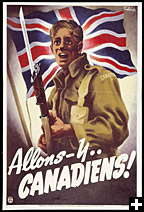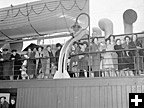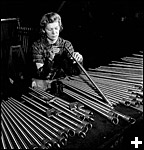Common menu bar links
Canadian statistics in 1943 and 1944
Archived Content
Information identified as archived is provided for reference, research or recordkeeping purposes. It is not subject to the Government of Canada Web Standards and has not been altered or updated since it was archived. Please contact us to request a format other than those available.

On September 10, 1939, Canada declared war on Germany and entered the Second World War.
The Dominion Bureau of Statistics assisted committees and other government departments involved in the war effort. For instance, it produced approximately 8 million registration cards for Canadians aged 16 to 69, as required by the National Registration Act of 1940. These cards recorded racial origin, birthplace, nationality, education and work experience. Used mainly to enlist single men into military service, the cards were also used to find skilled labour for Canada’s wartime industries.
At the end of the war, most of the statistics produced and compiled to support the war effort were no longer needed, but “some met continuing postwar needs and were transferred to the Bureau.”
Robert Hamilton Coats retires
The Dominion Bureau of Statistics struggled during the war because of staff shortages. By mid-1941 men of military age could no longer receive appointments to the public service and there was a great deal of competition for staff between government departments. Robert Hamilton Coats, playfully called the ‘Old Guard,’ had been Dominion Statistician and controller of the census since 1915. Like many of his colleagues, he was persuaded to postpone his retirement to satisfy the bureau’s need for senior staff during the war.
On January 25, 1942, after twenty-six years of service, Coats finally retired. He was 68 years of age. Sedley A. Cudmore—Assistant Dominion Statistician since 1939 and a previous editor of the Canada Year Book—was appointed Dominion Statistician.
The Canada Year Book and the Second World War

By 1944, the war affected many aspects of the Canadian economy. According to the preface to the 1943/1944 edition of the Canada Year Book, “statistics of almost every chapter of this edition of the Year Book reflect the extent to which war production and war-time controls have played their parts in maintaining output and supporting the price structure against growing pressures from all sides.”
The Canada Year Book, like other publications at the Dominion Bureau of Statistics, was subject to censorship and paper shortages during the war. The Censorship Advisory Committee on Statistical publications, established in 1939, and the Directorate of Government Office Economies Control, established in 1942, reduced the number of the bureau’s publications from 50 in 1941/1942 to 19 in 1943/1944. The Canada Year Book was not printed in 1943; information on 1943 was included in the 1943/1944 edition.
People immigrating and working

The estimated population of Canada in 1943 was 11.8 million people.
The 1943/1944 edition of the Canada Year Book mentions that while immigration was naturally low during times of war, the numbers of immigrants arriving annually in Canada were lower in the years from 1932 to 1943 than the number of immigrants in the year 1897. Whereas 104,806 people immigrated in 1930, 20,591 immigrated in 1932, and only 8,504 immigrated in 1943.

Jobs in the manufacturing industry rose dramatically in the decade preceding 1941, with 42% more men and 47% more women in manufacturing, according to the 1931 and 1941 censuses. Female employment also rose in other sectors over the same decade; 20% more women worked in the service sector, 31% more worked in clerical positions and 31% more worked in trade.
Controlling communications
By 1943, Government of Canada had imposed war-time restrictions on various forms of transportation and communication. Fewer ships entered Canadian ports. Only 87,967 ships entered ports in 1943, compared with 103,795 in 1941. By 1943, 1.7 million radio stations operated in the country, compared with 1.4 million stations in 1941.
Civil air travel was an increasingly popular mode of transportation. In 1942, 242,170 people flew, up from 214,232 people in 1941.
Production and the economy
The 1943 program for agriculture called for increased output “to meet the needs for home consumption, for export to Britain and others of the United Nations, and to provide something additional for the relief of countries freed from enemy occupation.” The gross value of agricultural production was $2.1 billion in 1942, much higher than in 1941, when its gross value was $1.4 billion. In fact, agriculture—mainly livestock and dairy—was worth more in 1940 and 1941 than any other resource industry in Canada.
The expansion of production during the war also affected the manufacturing industry. Manufacturing increased 34% from 1940 to 1941. In 1943, 75% of all exports were war materials.
Fighting for Canada

From September 1942 to May 1944, the Armed Forces grew from 505,000 to 765,000 people, and in 1944 included more than 32,000 women. The Canadian Navy also grew; it had 300 ships in 1942 and over 700 in 1944. Royal Canadian Air Force grew from 4,000 people at the start of the war to over 206,000 by 1943. Canada had “become the third largest naval power and the fourth air power of the United Nations.”
